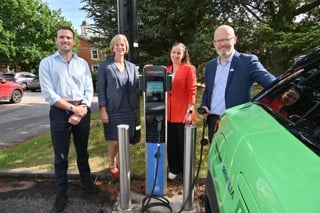MPs have suggested that more average speed cameras should be deployed on UK roads to catch motorists who drive too fast.
The total number of detected motoring offences has more than halved over the past decade: in 2004, the number of offences was 4.33 million, whereas in 2013 – the last year for which figures are available – there were 1.62m.
MPs on the Transport Committee claim some of this reduction may be down to decreased detection, as a result of cuts to specialised road traffic police.
It says more must be done to ensure detection rates are high, whether through specialised police officers or the greater use of technology.
Speed cameras, says the Transport Committee’s report on road traffic enforcement, are an “important and effective part of the technology toolkit” and, if enforcement is going to be effective, greater use of technology is essential.
It says that average speed cameras are generally “better received by motorists than traditional fixed speed cameras”, but existing schemes should be assessed for their long-term effectiveness and, based on this, Highways England should develop best practice for their deployment.
The report also says that, in pursuing any aim to improve speed limit compliance, speed camera placement must relate to safety rather than revenue, and be sited in such a way that aims to reduce casualties.
“We recommend that the Government monitor the placement of speed cameras by local authorities to ensure that this is the case,” the report continues. “Where revenue is taken from speed camera enforcement, the funding arrangements must be transparent and the revenue put back into road safety grants rather than kept by local authorities or the Treasury.”
The vast majority of fixed penalty notices (FPNs) issued for exceeding the speed limit are camera detected – 90% in England and Wales in 2014, accounting for 668,081 out of 743,054 FPNs.
The revenue generated by speed cameras is collected by the Treasury and goes into the consolidated fund – the main account of the Treasury. It is not specifically allocated for road safety purposes.
Data from the Department for Transport (DfT) shows that exceeding the speed limit was a contributory factor in 254 fatal accidents in 2014, 16% of all fatal accidents, as well as 1,199 serious accidents, making it the fourth most prevalent contributory factor in fatal collisions.
David Davies, executive director of the Parliamentary Advisory Council for Transport Safety (PACTS) told the committee that the A9 scheme in Scotland, which is now the longest non-motorway stretch of road with average speed cameras, has seen “safety and traffic benefits” that so far seem to have been “substantial”.
Analysis by technology association Intelligent Transport Systems suggests that the proportion of vehicles speeding in the A9 controlled zone fell from as high as 40% to roughly 10%, since the introduction of average speed cameras.
It said, where average speed camera enforcement is used as part of a casualty reduction measure, ‘killed or seriously injured’ rates dropped on average by more than 70%.
However, many fleets remain unconvinced of the road safety benefits of speed cameras.
A recent Fleet News poll showed that only one-third (33.5%) of respondents thought their use benefited road safety.
The suggestion of the greater use of speed cameras also comes in the wake of data from Lex Autolease showing that the total fines and penalties bill for businesses came in at £11.1m last year, up 17% on 2014.
And, according to the 2015 RAC Report on Motoring, seven in 10 motorists say they regularly or occasionally break the 70mph speed limit, which suggests there is an issue of compliance.
"It’s important that the solution to that problem offers a range of alternatives, and average speed cameras can be part of this,2 said RAC public affairs manager Nick Lyes.
“The benefit in using average speed cameras is that they have the advantage of measuring speed over distance, which is in marked contrast with fixed cameras which are often criticised for encouraging sharp braking and acceleration by drivers as they react to the cameras. This reaction can be a potential cause of accidents and does not help maintain steady flow of traffic.
"In addition, indications from the use of average speed cameras over a long distance on the A9 in Scotland appear to show positive compliance levels and a reduction in road traffic accidents.
“However, motorists will feel that the enforcement of road traffic law is not only about installing more cameras. The decline in road traffic police officers in recent years has been a worrying trend, with a 23% reduction in England and Wales between 2010 and 2014.
"The presence of road traffic police officers can also play a big part in improving both safety and compliance, as well as giving motorists a sense that law breakers are not just simply getting away with it.”
While recommending the greater use of average speed cameras, Louise Ellman, chairman of the Transport Committee, also recognises that they alone will not make UK roads safer.
“Inappropriate speed was a contributory factor in 16% of fatal collisions,” she said. “The vast majority of FPNs issued for exceeding the speed limit are camera-detected, but cameras cannot identify whether the driver is under the influence of alcohol or was driving carelessly.
“If enforcement of road traffic laws is to be effective, the decline in specialist roads policing officers must be halted.”























Nigel Boyle - 22/03/2016 11:32
The problem here is these camera work for 'steady speed' roads, eg dual carriage way or motorways. These are inheretly the savest roads; a person averaging 90 on a country lane is a lethal missile, but this technology will not work here. New technology is needed for the dangerous roads.